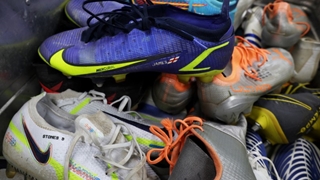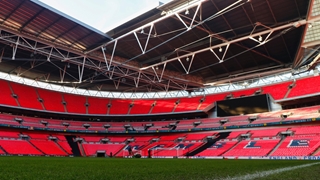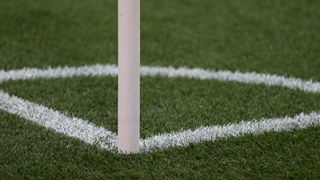
1. Safety
A player must not use equipment or wear anything that is dangerous.All items of jewellery (necklaces, rings, bracelets, earrings, leather bands, rubber bands, etc.) are forbidden and must be removed. Using tape to cover jewellery is not permitted.
The players must be inspected before the start of the match and substitutes before they enter the field of play. If a player is wearing or using unauthorised/dangerous equipment or jewellery the referee must order the player to:
- remove the item
- leave the field of play at the next stoppage if the player is unable or unwilling to comply
2. Compulsory equipment
The compulsory equipment of a player comprises the following separate items:- a shirt with sleeves
- shorts
- socks – tape or any material applied or worn externally must be the same colour as that part of the sock it is applied to or covers
- shinguards – these must be made of a suitable material and be of an appropriate size to provide reasonable protection and be covered by the socks. Players are responsible for the size and suitability of their shinguards
- footwear
The team captain must wear the armband issued or authorised by the relevant competition organiser, or a single-coloured armband that may also have the word ‘captain’ or the letter ‘C’ or a translation thereof, which should also be a single colour (see also ‘General modifications’).
A player whose footwear or shinguard is lost accidentally must replace it as soon as possible and no later than when the ball next goes out of play; if before doing so the player plays the ball and/or scores a goal, the goal is awarded.
3. Colours
- The two teams must wear colours that distinguish them from each other and the match officials
- Each goalkeeper must wear colours that are distinguishable from the other players and the match officials
- If the two goalkeepers’ shirts are the same colour and neither has another shirt, the referee allows the match to be played.
Undershirts must be:
- a single colour which is the same colour as the main colour of the shirt sleeve; or
- a pattern/colours which exactly replicate(s) the shirt sleeve
Undershorts/tights must be the same colour as the main colour of the shorts or the lowest part of the shorts – players of the same team must wear the same colour.
4. Other equipment
Non-dangerous protective equipment, for example gloves, headgear, facemasks and knee and arm protectors made of soft, lightweight padded material is permitted as are goalkeepers’ caps and sports spectacles. Goalkeepers may wear tracksuit bottoms.Head Covers
Where head covers (excluding goalkeepers' caps) are worn, they must:
- be black or the same main colour as the shirt (provided that the players of the same team wear the same colour)
- be in keeping with the professional appearance of the player’s equipment
- not be attached to the shirt
- not be dangerous to the player wearing it or any other player (e.g. opening/closing mechanism around neck)
- not have any part(s) extending out from the surface (protruding elements)
Electronic communication
Players (including substitutes/substituted and sent-off players) are not permitted to wear or use any for of electronic communication equipment (except where EPTS is allowed). The use of any form of electronic communication by team officials is permitted where it directly relates to player welfare or safety or for tactical/coaching reasons but only small, mobile, hand-held equipment (e.g. microphone, headphone, earphone, ear-piece, mobile phone/smartphone, smartwatch, tablet, laptop) may be used. A team official who uses unauthorised equipment or who behaves in an inappropriate manner as a result of the use of electronic or communication equipment will be sent off.
Electronic perfomance and tracking systems (EPTS)
Where wearable technology (WT) as part of electronic performance and tracking systems (EPTS) is used in matches played in an official competition organised under the auspices of FIFA, confederations or national football associations, the competition organiser must ensure that the technology attached to the players’ equipment is not dangerous and meets the requirements for wearable EPTS under the FIFA Quality Programme for EPTS.
Where EPTS are provided by the match or competition organiser, it is the responsibility of that match or competition organiser to ensure that the information and data transmitted from EPTS to the technical area during matches played in an official competition are reliable and accurate.
The FIFA Quality Programme for EPTS supports competition organisers with the approval process of reliable and accurate electronic performance and tracking systems.
5. Slogans, statements, images and advertising
Equipment must not have any political, religious or personal slogans, statements or images. Players must not reveal undergarments that show political, religious, personal slogans, statements or images, or advertising other than the manufacturer's logo. For any offence the player and/or the team will be sanctioned by the competition organiser, national football association or by FIFA.
Principles
- Law 4 applies to all equipment (including clothing) worn by players, substitutes and substituted players; it's principles also apply to all team officials in the technical area
- The following are (usually) permitted:
- the player's number, name, team crest/logo, initiative slogans/emblems promoting the game of football, respect and integrity as well as any advertising permitted by competition rules or national FA, confederation or FIFA regulations
- the facts of a match: teams, date, competition/event, venue
- Permitted slogans, statements or images should be confined to the shirt front and/or armband
- In some cases, the slogan, statement or image might only appear on the captain's armband
Interpreting the Law
When interpreting whether a slogan, statement or image is permissible, note should be taken of Law 12 (Fouls and Misconduct), which requires the referee to take action against a player who is guilty of:
- using offensive, insulting or abusive language and/or action(s)
- acting in a provocative, derisory or inflammatory way
Any slogan, statement or image which falls into any of these categories is not permitted.
Whilst 'religious' and 'personal' are relatively easily defined, 'political' is less clear but slogans, statements or images related to the following are not permitted:
- any person(s), living or dead (unless part of the official competition name)
- any local, regional, national or international political party/organisation/group, etc.
- any local, regional or national government or any of its departments, offices or functions
- any organisation which is discriminatory
- any organisation whose aims/actions are likely to offend a notable number of people
- any specific political act/event
When commemorating a significant national or international event, the sensibilities of the opposing team (including its supporters) and the general public should be carefully considered.
Competition rules may contain further restrictions/limitations, particularly in relation to the size, number and position of permitted slogans, statements and images. It is recommended that disputes relating to slogans, statements or images be resolved prior to a match/competition taking place.
6. Offences and sanctions
For any offence play need not be stopped and the player:- is instructed by the referee to leave the field of play to correct the equipment
- leaves when play stops, unless the equipment has already been corrected
- have the equipment checked by a match official before being allowed to re-enter
- only re-enter with the referee’s permission (which may be given during play)









